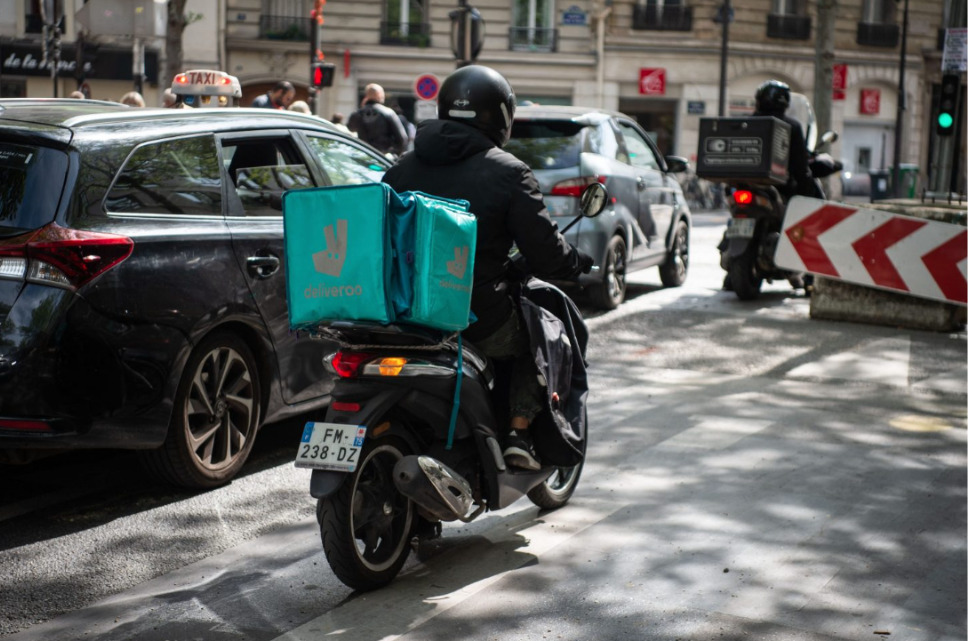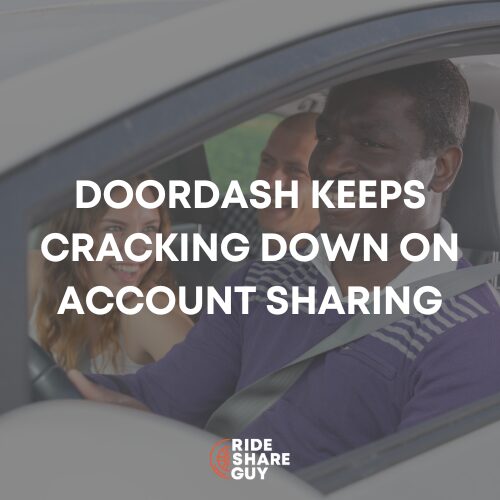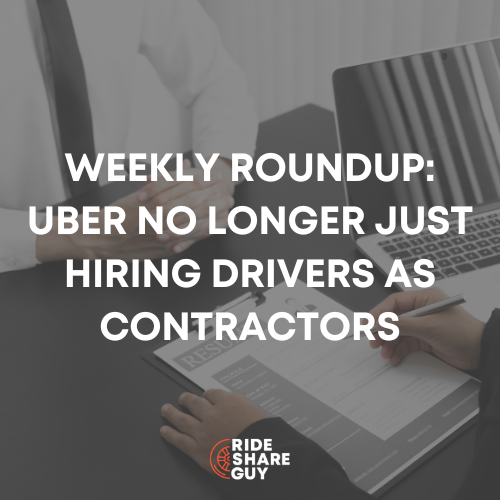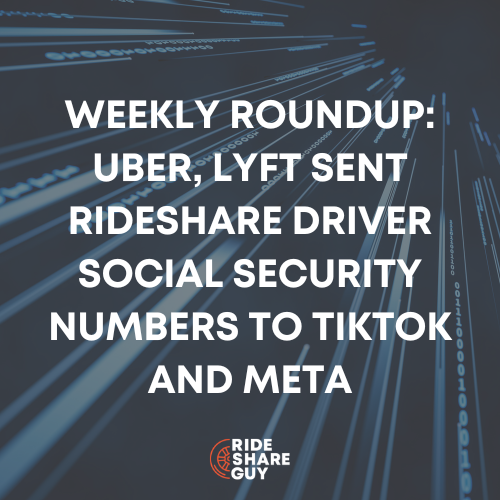Leading up to the holidays, people are a bit on edge. One woman took it far enough to steal her Uber driver’s car because they were driving too slow for her taste.
Also in the news, a new EU deal will have rideshare and delivery apps treating their drivers as employees.
Join RSG Contributor Paula Lemar as she breaks down the top headlines in this week’s rideshare news.
Fast And Furious: Woman Steals Uber Driver’s Car Before Flight In Texas For Being ‘Too Slow’
Topic Originally Appeared On Fox News
Summary
A woman is accused of stealing an Uber driver’s vehicle because they were “driving too slow” as she was being taken to Austin’s airport on Sunday, according to court documents obtained by Fox 7 Austin.

Austin woman arrested for stealing Uber driver’s car for “driving too slow.” (Austin Police Department)
According to an arrest affidavit, Neusha Alexandra Afkami, 27, was arrested for allegedly stealing the Uber driver’s vehicle and using the driver’s credit card without consent.
Just before 12:30 a.m. on Sunday, an Uber driver picked up Neusha Afkami, 27, from a hotel to take her to Austin-Bergstrom International Airport.
My Take
I get that it’s frustrating if you think your driver is too slow, but I really don’t think the solution is to steal their car. That seems a bit extreme.
I also firmly believe that it’s not difficult to leave yourself enough time to not feel rushed once you get to the airport. Leave with plenty of time. If you’re ordering a driver, give yourself even more time.
The world is a wild place, and people get more intense around the holidays. Keep safe out there, drivers!
Uber, Deliveroo, And Other Ride-Hailing And Food-Delivery Platforms Will Have To Treat 5.5m Gig Workers As Employees Under New EU Deal
Topic Originally Appeared On Fortune
Summary
European Union negotiators backed a deal to reclassify millions of people working for ride-hailing and food-delivery apps as employees in a set of rules that could cost the industry billions of euros each year.

The provisional deal will require platforms to give full status to the estimated 5.5 million workers who meet at least two out of five conditions that indicate their relationship with the apps fits that of an employee rather than someone who’s self-employed, the EU said in a statement on Wednesday.
Those conditions include limits on worker pay, performance supervision, control of the distribution of tasks, control over working conditions and hours, and rules around appearance and conduct, including restrictions on freedom to organize.
My Take
With how hard Uber and other rideshare and delivery platforms have fought back in the States on measures similar to this, I wouldn’t be surprised if they fight this as well.
In reading the article, there are a lot of great things that are beneficial to drivers. One that stands out to me is that the platforms will be required “to tell workers when they’re being monitored or managed by algorithms.”
Drivers are often suspicious of when an algorithm is playing them, but this would confirm their assumptions.
Of course, there will likely be platforms that will threaten to leave various markets because of these regulations. And/or the platforms will threaten to increase prices to a degree that may hinder customers from wanting to use the platforms.
Of course, they’ll do whatever they can to convince the world that their way is better than anything else that’s proposed.
Here’s hoping this regulation stays to the benefit of the drivers. This is groundbreaking and sets a new precedent for these platforms across the globe.
This NFL Player-Turned-Dasher Has a New Perspective On His Community
Topic Originally Appeared On DoorDash Blog
Summary
Drue Chrisman is no ordinary professional football player. He’s a punter who began his career at Ohio State, played for the Cincinnati Bengals, and spent two months working as a Dasher for DoorDash.
On a recent chilly December morning, he got on the phone from his home in Lawrenceburg, Indiana. It’s a small town on the Ohio River, with a population of approximately 5,000 and a stone’s throw from Cincinnati, where Chrisman grew up and launched his football career.
Chrisman confesses that he’s “a little sleepy” because it’s the morning after Monday Night Football, where he appears as a local commentator for the Bengals. Being a commentator is temporary, a placeholder job before he lands on his next team.
Becoming a punter defined Chrisman’s life, and so, too, he says, did becoming a Dasher. It was an experience he dove into this past summer before football’s preseason.
Chrisman had opted to stay in Cincinnati to be near family — he and his wife have a 17-month-old daughter — and was looking for a way to fill some of the time.
“I would usually go in the offseason to train with my coach,” he says. “Just a little tougher with a toddler, dragging them along everywhere you go.”
My Take
We’ve covered Drue before, back in June, when he answered the question, “why are you doing DoorDash, Drue?” and he responded:
“I use the money I make to spend at local restaurants and hand the food out around town. Hope that clears some things up :)”
<blockquote class=”twitter-tweet”><p lang=”en” dir=”ltr”>To answer the question “why are you doing DoorDash Drue?”<br><br>I use the money I make to spend at local restaurants and hand the food out around town. Hope that clears some things up 🙂 <a href=”https://t.co/1FUdHM35yk”>pic.twitter.com/1FUdHM35yk</a></p>— Drue Chrisman (@DChrisman91) <a href=”https://twitter.com/DChrisman91/status/1671486569482420226?ref_src=twsrc%5Etfw”>June 21, 2023</a></blockquote> <script async src=”https://platform.twitter.com/widgets.js” charset=”utf-8″></script>
It’s great to see people who are in positions of power and/or wealth and use it for the betterment of their communities.
Women Who Drive For Uber And Lyft Share Tips For Staying Safe In Gig-Economy Jobs
Topic Originally Appeared On Business Insider (archive.ph)
Summary
The last time you called for an Uber or Lyft, there’s a good chance your driver was a man.
That’s because men are more likely to be ride-hailing drivers than women. A recent survey put the share of women Lyft drivers at 23%, a company spokesperson told Business Insider. As of 2019, about 20% of Uber drivers were women — the company didn’t provide a more updated figure.
While this disparity likely has several explanations, safety concerns are among the factors that have made some women hesitate before entering the gig economy.
In 2019 and 2020, for instance, the most recent years data is available, nearly 4,000 incidents of sexual assault were reported to Uber — the rider was the accused party in 43% of incidents. In 2018 and 2019, Lyft received over 3,000 reports of sexual assault from riders and drivers.
But these concerns haven’t stopped all women from using Uber and Lyft to generate income. Business Insider spoke with three women who drive for these companies about their worst experiences — and the steps they’ve taken to feel safer.
My Take
We also have safety tips for all drivers. You can read about them in Jay’s article Safety for Uber Drivers: Tips to Protect Yourself on the Road.
While it’s great to protect women drivers, all drivers need to follow safety precautions. The world is a crazy, dangerous place, and there are only so many protections in place for drivers through the platforms themselves.
You can take all the safety precautions you can think of, but nothing will protect you 100%. The safety tips in the Business Insider article are helpful, but there’s always more you can do.
One thing I will add to this list is taking basic self-defense classes. It is even better if you can find ones that are geared toward being in an enclosed space like a vehicle.
One thing that the driver told me once that I had never even considered was asking your passenger to sit in the back on the passenger side instead of directly behind you if at all possible.
You’ll keep them in your line of sight while also helping prevent them from being able to choke you from behind.
All drivers should be alert, aware of their surroundings, and able to read the room.
How An Only-In-California Law Could Allow One Uber Driver To Singlehandedly Upend The Gig Economy
Topic Originally Appeared On Fortune
Summary
The gig economy, a realm once celebrated for its convenience and dynamism, is standing at a crossroads. A recent opinion by the California State Supreme Court against Uber could be the catalyst for much-needed change, pushing for a fairer deal for gig workers.
The court recently allowed a special lawsuit to be brought against Uber from drivers demanding coverage for work-related expenses. This decision highlights the back-and-forth struggle for the soul of the gig economy in California—and possibly throughout the United States.
Erik Adolph, the UberEats driver at the heart of this case, is not merely a plaintiff. He symbolizes the struggle of gig workers seeking fair compensation against a system that often feels stacked against them.
For years, companies like Uber have used the label of “independent contractor,” sidestepping potentially cumbersome employment laws that mandate benefits such as minimum wage, health insurance, and expense reimbursements.
The essence of Adolph’s lawsuit is to permit a specific cause of action to challenge this model.
However, this practice of classifying workers as independent contractors isn’t solely a tactic utilized by these companies. It has legal backing, most prominently in the form of California’s contentious Proposition 22.
Passed in 2020, this measure, which was one of the most expensive ballot initiatives in the state’s history, allows gig-based apps to define their workers as independent contractors instead of employees.
Even though a California appeals court affirmed the validity of Proposition 22 as recently as March of this year, the contention is far from settled, and the tug-of-war over worker classification in the gig economy is ongoing.
My Take
I recommend reading the whole article. This fight for drivers’ rights is going to be ongoing for several years. It’s a veritable tug-of-war that is spreading across the country.
Uber and its competitors are going to find themselves in more and more battles with their drivers for basic employment rights.
And we’ll be here to keep you informed.
RSG in the News This Week
Read more trending topics in the news this week:
- Uber’s CEO Hides Driver Pay Cuts To Boost Profits
- Professor Len Sherman will be live on the next episode of SMTMC on Tuesday, so make sure to check it out!
Must Listen Or Watch RSG Content
Here are this week’s featured podcast episode and YouTube videos:
- RSG249: David Zipper on Why Robotaxis Will Be Even Worse Than Ridehail
- ULTIMATE Gift Giving Guide For Rideshare Drivers (48 GIFT IDEAS)
- Lyft Lux Is Gone BUT This Driver Figured It Out
- How To Make $100,000 In A Year Driving Uber & Lyft!
- Make sure you Subscribe so you don’t miss out on future conversations and interviews!





